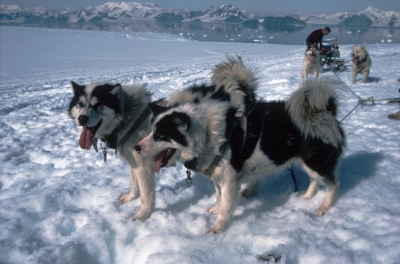
Sled dogs played an important role in Antarctica exploration. However, all dogs have been banned from Antarctica since 1994. This ban was imposed out of concern that the non-native dogs could spread diseases such as canine distemper to the native seals in the icy continent.
Sledge dogs were used by BAS in the Antarctic from 1945. The original dogs were imported from the Arctic, from Labrador in Canada and there were small additions in stock from Greenland (1954 and 1961). Careful records were kept of the breeding to avoid producing dogs affected by hereditary disorders. Dogs were also exchanged between bases in Antarctica (eg. Argentinian base, San Martin) in order to maintain genetic diversity. At British stations, dogs were generally fed on seal meat and therefore a certain number of seals were killed each year to support them. The dogs were gradually replaced by mechanised transport during the 60s and 70s and skidoos became the main vehicle for transporting field parties overland.
In the 1980’s and early 1990’s, a small number of dogs were kept at Rothera Research Station for recreational purposes. The dogs were well looked after and gave station personnel the chance to get a feel for what the earlier explorers and scientists would have experienced. The dogs were also considered to be good for morale, which is important in an environment where people are away from home for periods of over two years. There was considerable resistance from station personnel when the legislation for the removal of the dogs was put in place.
The 14 remaining dogs were finally removed from Rothera in February 1994. To mark the end of the era, the dogs spent the last season doing what they did best, pulling a sledge as a working team in support of a surveying project on Alexander Island. When the dogs finally departed Rothera, special husky kennels were built and fitted inside the BAS Dash 7 aircraft for the 5-hour flight to the Falkland Islands. The dogs spent several weeks adapting to the warmer climate and new surroundings, experiencing grass, sheep and children for the first time. They flew from the Falklands to the UK on a special RAF Tristar flight. Once again the dogs received a warm welcome to the UK, this time becoming media stars in all the national papers. Once quarantine was completed the final leg of their journey took them to Quebec in Canada, courtesy of British Airways.
Of the 13 dogs who arrived in Canada, 5 died within the first year due to infection and disease. Unfortunately it was not possible to breed from any of the remaining dogs and the last two died in 2001.
Credit : British Antarctic Survey
Picture Credit : Google




